ASUS PQ321Q UltraHD Monitor Review: Living with a 31.5-inch 4K Desktop Display
by Chris Heinonen on July 23, 2013 9:01 AM ESTUniformity is tested by using 25 locations across the screen and measuring the color checker chart at each of them. From there we can pull out contrast, black and white uniformity, and color uniformity. This review is the first to utilize the newest measurement available in CalMAN 5.1.2: dE From Center. Now instead of measuring the dE2000 at every location, we measure it relative to the center measurement.
This gives us a true uniformity measure. I could measure the left side and the right side of the monitor and get a dE2000 of 2.0 for each side. What that doesn’t tell me is that the left side might be red tinted, and the right side blue tinted, while the center might be green tinted. In this case they could all measure the same dE2000, but look totally different. By comparing the measured values to the center, we get an actual measurement of if one area of the screen will look the same as another area. Since we always use the center of the screen as our calibration target, which is why everything is measured relative to that.
Starting out with White Uniformity, we see decent but not amazing results. The panel stays within +/- 10% for the center, but falls down to a 17% variation at the edges. The light fall-off is relatively high, and makes me wonder if the look of the panel, and its thin design, might place a bit of emphasis on style over substance.
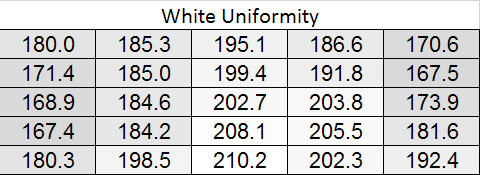

With the black level charts we see similar results. The middle of the panel is +/- 10% again, but the edges fall off to a nearly 20% difference. There is a curious rise in black level in one measure where there was a fall-off in white level, but otherwise the results between the two measurements are similar.
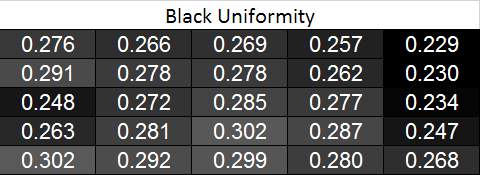
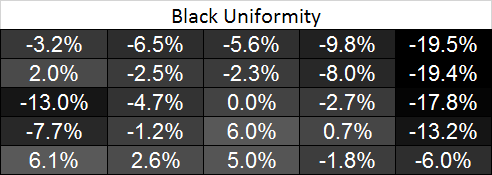
Looking at the resulting contrast, the numbers here are much closer to 100%, which we expect to see. Areas with light fall-off affect the white and black levels almost equally, so the contrast ratios are very similar all across the screen. That gives us a 700:1 expected contrast ratio for the screen as a whole.
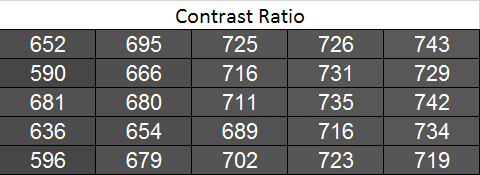
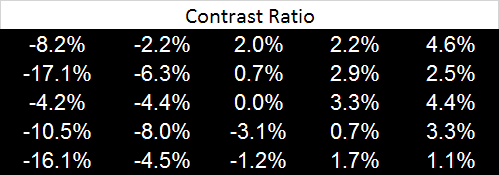
Now we can see the new dE2000 From Center data. The issues here crop up at the outsides of the screen, where we see the backlighting issues earlier. Uneven lighting is the issue most likely to cause color issues on the screen, and that is certainly backed up here. In the center of the screen, you are going to not see a difference in colors when you look directly at the screen. With a light loss of less than 10%, and a color dE2000 of <2 for most of the center screen, everything will look identical. As you get to the extreme edges you will run into more issues. I will need more monitors to be tested with this new method, but I think this is going to wind up as a good result in the end.

Going with an LED lighting system, and not a backlit array one, is always a bit of a concern for me. Overall the PQ321Q does well for uniformity for using one, and it avoids some of the massive issues we have seen with some LED systems before. But we are looking for near-perfection from the ASUS and it can’t quite do that. The center 60% of the screen is excellent overall, and for most people that will mean you may not notice these issues at all, but they are there.










166 Comments
View All Comments
noeldillabough - Tuesday, July 23, 2013 - link
Damn my current monitors are 1920x1200 and I was hoping "real 4K" was 2x2 of that.JDG1980 - Tuesday, July 23, 2013 - link
Search around on eBay for an IBM T220 or T221. These have a 3840x2400 resolution (though only a 48 Hz refresh rate), and usually cost about $800-$1500. They aren't always there, but show up on a semi-regular basis.cheinonen - Tuesday, July 23, 2013 - link
Technically it's UHD, though everyone uses 4K for 3840x2160 anyway. I'm trying to avoid it to be more accurate, but since everyone refers to their display as a 4K model, I often fall back to it. UHD would be more accurate, though.Synaesthesia - Tuesday, July 23, 2013 - link
I'd love if you could test with a Mac Pro and see how it does with the "retina" display mode, i.e. effectively the space of a 1080p display but with double the sharpness.twtech - Tuesday, July 23, 2013 - link
I think you'll see a little bit of both in terms of using scaling, and the physical size of elements onscreen. Things will have to be scaled somewhat, but text for example won't have to be just as big as it was before.BubbaJoe TBoneMalone - Tuesday, July 23, 2013 - link
Unfortunately, for gamers, there isn't a video card that can handle 60fps at 4k with maximum video settings. Not even with 3 titans as shown on this video -> http://www.youtube.com/watch?v=Wa-DRVqPJRonoeldillabough - Tuesday, July 23, 2013 - link
Just think of the videocards that will sell ... the next "big thing" for AMD and nVidia; because let's face it, Intel is catching up far too quickly for their comfort at low resolutions.airmantharp - Tuesday, July 23, 2013 - link
Why would you run it at maximum settings? Gotta love the FUD peddlers.DanNeely - Thursday, July 25, 2013 - link
140DPI at desktop monitor distances isn't high enough DPI to do without AA; and if you can't run at native resolution with all the other settings maxed you'd be better off running at 2560x or 1920x on a panel that natively supports that resolution to avoid scaling artifacts and scaling lag in the panel itself.Panzerknacker - Tuesday, July 23, 2013 - link
I don't understand the people hating at 4k and saying they intend to stay with 1080p. I mean common, everybody wants something new right? I think the LCD technique and LCD displays are far from perfect yet, and despite they clearly have their advantages over CRT, they still also clearly have their disadvantages.I see this as one step closer to beating CRT. Now that with 4K we finally are at a higher pixel density, a level of sharpness that will be hard to improve on, I hope the focus will shift towards improving black levels, response times and overal picture 'feeling' (watching a LCD is still like staring at a LED lamp, while CRT gives the much nicer light bulb feeling), and bringing back the nice glow effects in games we enjoyed on CRT's that appear like washed out collored spots on a LCD.
Good review btw.